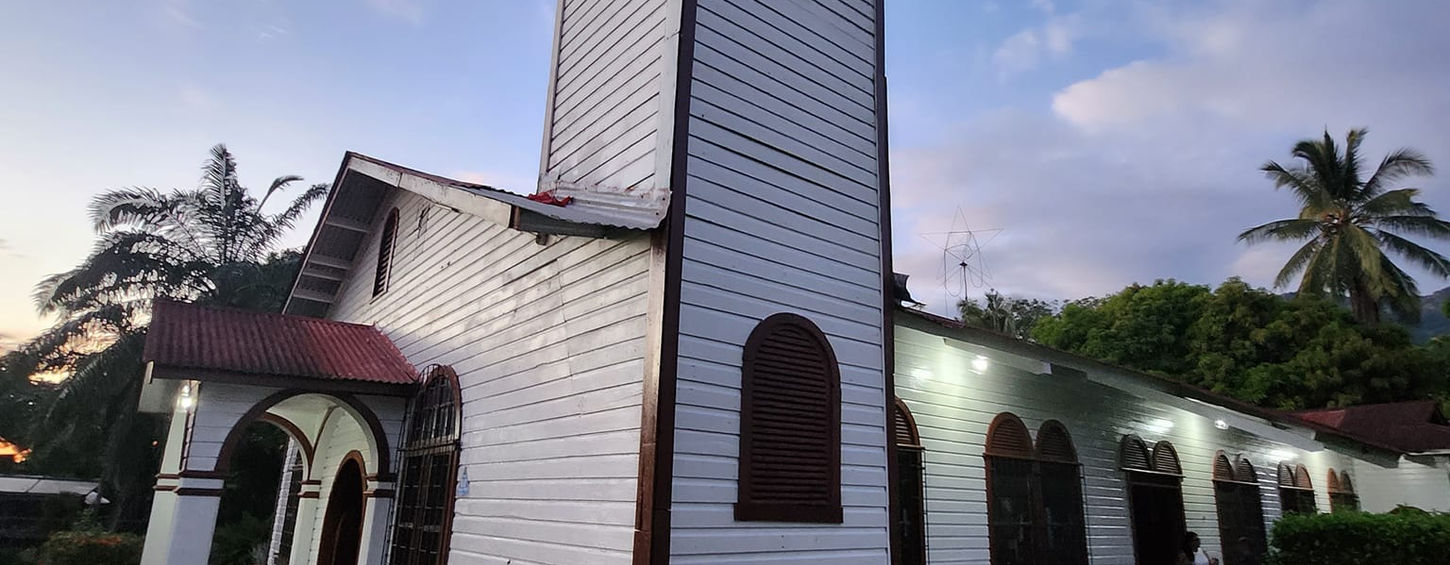Many places (tourist or not) are worth a detour for the beauty of their landscape, the cultural interest or their unique particularity which characterizes them. Some of these places are touristy but others are more confidential and worth visiting. Find all of these places here and share your discoveries with us!
Costa Rica's architectural cultural heritage, the Catholic Church of the Sacred Heart of Jesus in Palmar Sur is worth the detour.
En 1936, la United Fruit Company a décidé d'établir une série de plantations de bananes dans la région de Palmar de los Indios et c'est ainsi que Palmar Sur a vu le jour. Ici, l'entreprise bananière a établi le même plan d'urbanisme qu'elle avait mis en œuvre à Golfito et dans d'autres régions du sud du pays, tant pour la construction de logements que pour l'emplacement des services et des bâtiments les plus importants. En 1952, la société bananière décide de construire sur le site une église catholique destinée à assurer les services religieux des ouvriers. À cette fin, du pin rouge a été importé du Honduras et la conception architecturale prévue dans la typologie bananière a été mise en œuvre dans le bâtiment. Pour cette raison, la construction est stylistiquement similaire aux temples que l'entreprise bananière a construits à Golfito et Coto 47. Il est possible que la conception corresponde à l'ingénieur Daniel Radán, d'origine libanaise, responsable de l'ingénierie et de la construction de l'entreprise bananière, c'est également possible. qu'Aniceto Rodríguez supervise les travaux de construction. À ses débuts, l'église était sous la garde de prêtres américains de l'ordre franciscain et les premiers furent les prêtres Kiliano et Samuel Steward. Après leur départ, d'autres prêtres franciscains ont continué, mais membres du clergé national. Avec la fermeture de l'usine de bananes au milieu des années 1980, les franciscains de Palmar Sur ont également pris leur retraite. Le changement dans l'administration du temple s'est produit en 1992 avec l'arrivée des sœurs Bethlémite
Costa Rica's architectural cultural heritage, the Catholic Church of the Sacred Heart of Jesus in Palmar Sur is worth the detour.
In 1936, the United Fruit Company decided to establish a series of banana plantations in the Palmar de los Indios region and this is how Palmar Sur came into existence. Here the banana company established the same urban plan that it had implemented in Golfito and other regions in the south of the country, both for the construction of housing and for the location of services and buildings the most importants. In 1952, the banana company decided to build a Catholic church on the site intended to provide religious services for the workers. For this purpose, red pine was imported from Honduras and the architectural design planned in the banana typology was implemented in the building. For this reason, the construction is stylistically similar to the temples that the banana company built in Golfito and Coto 47. It is possible that the design corresponds to the engineer Daniel Radán, of Lebanese origin, responsible for the engineering and building the banana business is also possible. that Aniceto Rodríguez supervises the construction work. In its early days, the church was under the care of American priests of the Franciscan order and the first were Priests Kiliano and Samuel Steward. After their departure, other Franciscan priests continued, but members of the national clergy. With the closure of the banana factory in the mid-1980s, the Franciscans of Palmar Sur also retired. The change in temple administration occurred in 1992 with the arrival of the Bethlemite sisters
Recently, in 2015, as it is called today, the Catholic Church of the Sacred Heart of Jesus of Palmar Sur, was declared by the Center for the Conservation of Cultural Heritage of Costa Rica as Architectural Cultural Heritage, this, for its symbolic, historical, contextual and ancient value.
Costa Rica's architectural cultural heritage, the Catholic Church of the Sacred Heart of Jesus in Palmar Sur is worth the detour.
In 1936, the United Fruit Company decided to establish a series of banana plantations in the Palmar de los Indios region and this is how Palmar Sur came into existence. Here the banana company established the same urban plan that it had implemented in Golfito and other regions in the south of the country, both for the construction of housing and for the location of services and buildings the most importants. In 1952, the banana company decided to build a Catholic church on the site intended to provide religious services for the workers. For this purpose, red pine was imported from Honduras and the architectural design planned in the banana typology was implemented in the building. For this reason, the construction is stylistically similar to the temples that the banana company built in Golfito and Coto 47. It is possible that the design corresponds to the engineer Daniel Radán, of Lebanese origin, responsible for the engineering and building the banana business is also possible. that Aniceto Rodríguez supervises the construction work. In its early days, the church was under the care of American priests of the Franciscan order and the first were Priests Kiliano and Samuel Steward. After their departure, other Franciscan priests continued, but members of the national clergy. With the closure of the banana factory in the mid-1980s, the Franciscans of Palmar Sur also retired. The change in temple administration occurred in 1992 with the arrival of the Bethlemite sisters
Recently, in 2015, as it is called today, the Catholic Church of the Sacred Heart of Jesus of Palmar Sur, was declared by the Center for the Conservation of Cultural Heritage of Costa Rica as Architectural Cultural Heritage, this, for its symbolic, historical, contextual and ancient value.
NOT TRANSLATED
Architectural cultural heritage of Costa Rica, the Catholic Church of the Sacred Heart of Jesus in Palmar Sur is worth the detour to admire its typical and charming architecture, one of the rare vestiges of the era and historical memory of Palmar and the Canton. A few hundred meters away, you can also take the opportunity to admire the “maquina Negra”, a former locomotive of the banana company.





















_edited_edited.jpg)



.jpg)



